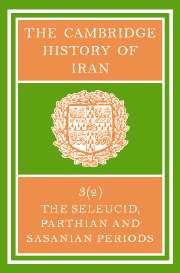Book contents
- Frontmatter
- PART 5 INSTITUTIONS
- 18 IRANIAN SOCIETY AND LAW
- 19 POLITICAL, SOCIAL AND ADMINISTRATIVE INSTITUTIONS, TAXES AND TRADE
- 20 GEOGRAPHICAL AND ADMINISTRATIVE DIVISIONS: SETTLEMENTS AND ECONOMY
- 21(a) TIME-RECKONING
- (b) IRANIAN FESTIVALS
- PART 6 RELIGIOUS HISTORY
- PART 7 ART HISTORY
- PART 8 LANGUAGES AND LITERATURE
- PART 9 BIBLIOGRAPHY
- Bibliography
- Index
- Index of Greek words
- References
19 - POLITICAL, SOCIAL AND ADMINISTRATIVE INSTITUTIONS, TAXES AND TRADE
from PART 5 - INSTITUTIONS
Published online by Cambridge University Press: 28 March 2008
- Frontmatter
- PART 5 INSTITUTIONS
- 18 IRANIAN SOCIETY AND LAW
- 19 POLITICAL, SOCIAL AND ADMINISTRATIVE INSTITUTIONS, TAXES AND TRADE
- 20 GEOGRAPHICAL AND ADMINISTRATIVE DIVISIONS: SETTLEMENTS AND ECONOMY
- 21(a) TIME-RECKONING
- (b) IRANIAN FESTIVALS
- PART 6 RELIGIOUS HISTORY
- PART 7 ART HISTORY
- PART 8 LANGUAGES AND LITERATURE
- PART 9 BIBLIOGRAPHY
- Bibliography
- Index
- Index of Greek words
- References
Summary
SOURCES
The written sources for the organization of the state in Parthian and early Sasanian times are various and heterogeneous. The historian finds himself dealing with two points of view which rarely coincide. The first of these is represented for the most part by authors writing in Greek and Latin (mainly for the Parthian period), and also in Syriac, Armenian, Arabic, Chinese and other languages (mainly for the Sasanian period). Thus, some sections of the history of the Parthian and Sasanian states are known to us only through “a view from the West” or “a view from the Far East”, and it remains dubious what particular Parthian or Sasanian institutions a given writer had in mind when he adapted ideas that he did not fully understand to his own, alien terminology. The second point of view is represented by indigenous sources.
The sources in the Parthian language consist mostly of fragmentary epigraphic material. This principally takes the form of potsherds found by the South-Turkmenistan Archaeological Expedition to Nisā: the archive of a wine storehouse (mdwstn) in the 1st century b.c., containing over 2,000 documents which have survived to the present day. A small number of potsherds, records of issues of corn to the Persian garrison, have been found at Dura-Europos. They belong to the middle of the 3rd century a.d. Some graffiti in various languages (including Parthian) were also found there, together with a few parchments in Parthian and Greek – contracts and business documents.
- Type
- Chapter
- Information
- The Cambridge History of IranSeleucid Parthian, pp. 681 - 746Publisher: Cambridge University PressPrint publication year: 1983
References
- 5
- Cited by



